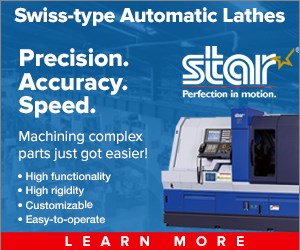SERVICES
Narrow by Services Product Category
- Appraisals
- Books, Publications & Information
- Catalog & Equipment Outlets
- Conference & Exhibition Organizers
- Consulting
- Consulting Services, R&D Institutes, Labs
- Deburring Services
- Finishing Services
- Internet-Only Machine Tool Sales (New & Used)
- Leasing & Financing
- Machining Services
- Maintenance & Repair
- Metal Sales & Services, Internet-Only
- Printed Circuit Board Design & Manufacturing
- Quality & Measurement
- Reclamation/Recycling Services, Scrap Dealers
- Recruitment & Placement Services
- Replacement & Repair Parts
- Request for Quote Services, Internet-Only
- Retrofitting, Rebuilding, Remanufacturing Services
- Shipping & Logistics
- Trade Associations, Societies, Gov. Agencies
- Training
- Universities, Colleges & Research Centers
FAQ: Services
How do I find a repair service for old machine tools?
When a shop has machine tool service needs, the first thought might be to directly contact the original equipment manufacturer (OEM) or distributor to request repairs. But that option may or may not be the most practical or cost effective, depending on the type of repair needed. When service is needed quickly, a network that connects service requesters (machine shops) to any type of service provider (including OEMs, distributors and independent providers) can be the fastest way for a machine shop of any size to compare repair quotes at one time.
The Up! App (the name refers to machine tool uptime) does just that by providing a space for machine shops to submit a request for service by entering their machine tools by OEM and model number with the option to include accompanying photos, videos and/or text chat to help explain the problem. Then, a service provider who is knowledgeable about the machine type can respond with an estimate or a comment using the chat function. The two parties can chat back and forth, and even do a video call, which is Up!’s newest functionality.
Having the ability to chat or do a live video call through the app prior to a service call enables the service requester to develop a desired comfort level with the service provider to decide whether the provider can help with a particular repair. The video camera within the app, which is independent of the device being used, can also be a tool to help demonstrate the repair needed. This additional information can give the provider the ability to estimate more accurately.
(Source: Network Quickly Connects Machine Shops with Repair Estimates)
What should be included in my machine shop training?
These five safety topics should be a focus for your shop’s safety training, according to Miles Free, director of industry affairs, Precision Machined Products Association (PMPA). The first four topics are based on top Occupational Health and Safety Administration (OSHA) violations in General Industry. The last topic is often overlooked, Free believes, but is foundational to an effective safety program.
- Hazard Communication. Employers shall develop, implement and maintain at each workplace, a written hazard communication program that at least describes how labels and other forms of warning, safety data sheets, and employee information and training will be met. This also includes a list of the hazardous chemicals known to be present using a product identifier that is referenced on the appropriate safety data sheet (the list may be compiled for the workplace as a whole or for individual work areas); and the methods the employer will use to inform employees of the hazards of non-routine tasks and the hazards associated with chemicals contained in unlabeled pipes in their work areas. gbm.media/hazard
- Control of Hazardous Energy – Lockout/Tagout. Employers in our industry need to be especially aware of the Minor Servicing Exemption (Kershaw Rule). Visit gbm.media/Kershaw. The employer shall establish a program consisting of energy control procedures, employee training and periodic inspections to ensure that before any employee performs any servicing or maintenance on a machine or equipment where the unexpected energizing, startup or release of stored energy could occur and cause injury. The machine or equipment shall be isolated from the energy source and rendered inoperative. gbm.media/energycont
- Powered Industrial Trucks. Powered industrial trucks (for example, fork trucks, tractors, lift trucks and motorized hand trucks) are ubiquitous in shops. While the current standard focuses on operator competence, the safety of others present in the workplace that could be struck by powered industrial trucks should also be addressed. The employer shall ensure that each powered industrial truck operator is competent to operate a powered industrial truck safely, as demonstrated by the successful completion of the training and evaluation specified in this paragraph. gbm.media/industruck
- Machinery and Machine Guarding — Mechanical Power Presses. Our shops rely on machines using energy to convert raw materials into finished products. Pinch points, physical impact, caught between and entanglement are a few of the hazards for the unwary. In addition to installation and use of proper guarding, inspection and maintenance records are required regularly and periodically to fully meet the requirements of this regulation. It shall be the responsibility of the employer to provide and ensure the usage of "point of operation guards" or properly applied and adjusted point of operation devices on every operation performed on a mechanical power press. The employer shall establish and follow an inspection program. gbm.media/guarding
- Emergency Action Plans. The foundation of a shop’s emergency response should be planned, not improvisational. Who is responsible? Who has authority? Is there a plan? What does it entail? What evidence is there that performers have been trained? An emergency action plan must be in writing, kept in the workplace and available to employees for review. (An employer with 10 or fewer employees may communicate the plan orally to employees.) gbm.media/eap
(Source: 5 Topics for Machine Shop Training)
Get Listed!
Thousands of people visit this Supplier Guide every day to source equipment and materials. Get in front of them with a free company profile.








